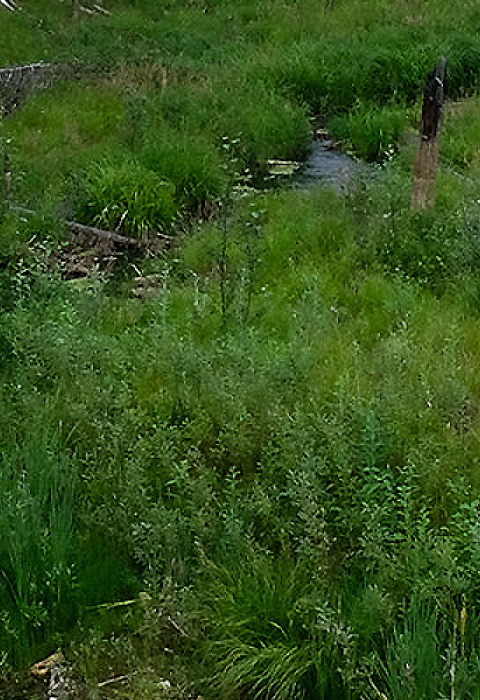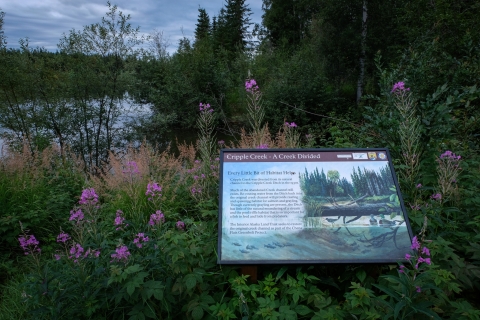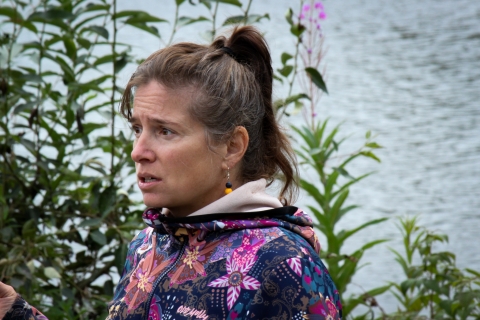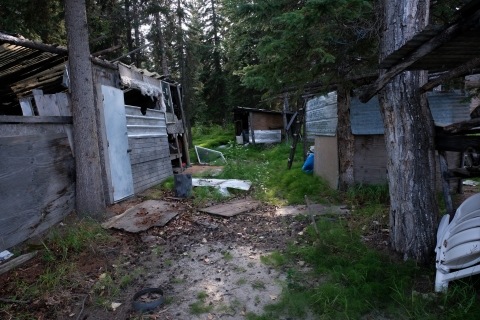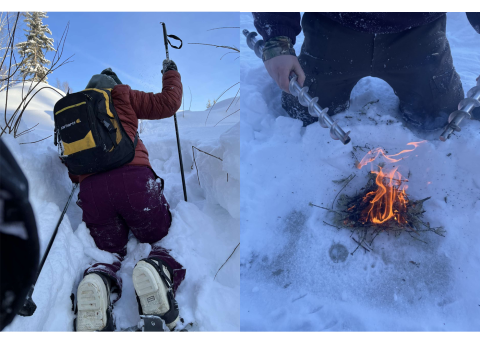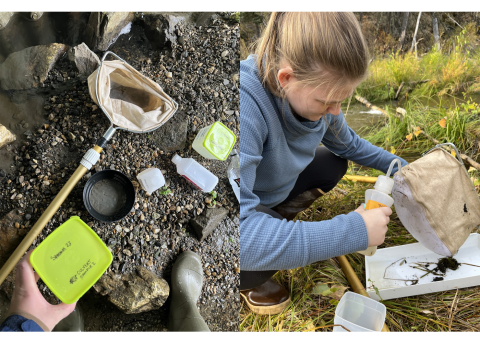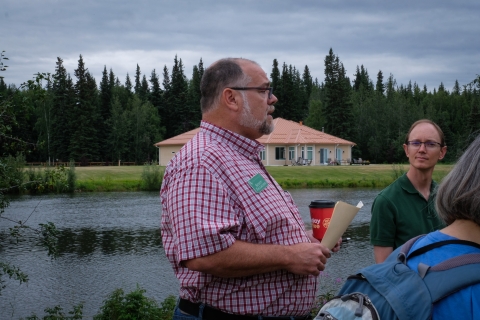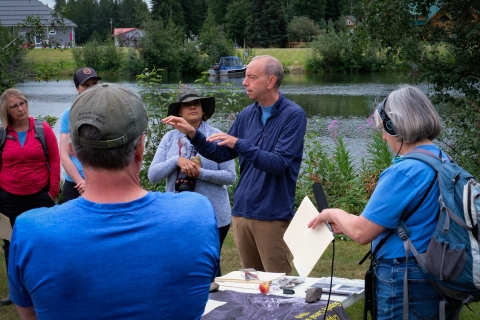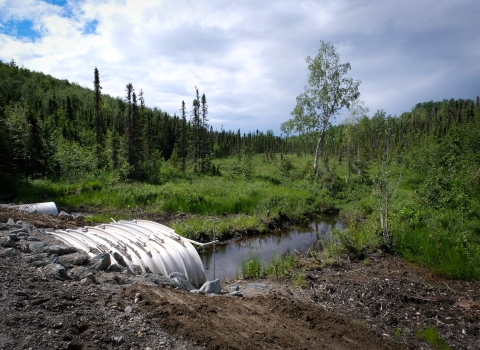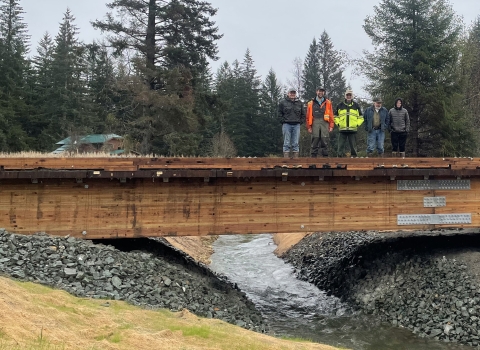Mitch Osborne, as is often the case when the conversation turns to salmon, spoke excitedly – waving his arms, pointing to maps, lifting photographs high in the air – when a distant silver flash caught suddenly his eye, interrupting his runaway address.
The two dozen-person crowd followed his finger to the banks of the Chena River and laughed as Osborne, a now-retired Service biologist, became suddenly absorbed in the hawk-eyed sighting: “There’s a little fish hitting over on the far side.”
The fish – perhaps a salmon, perhaps a cisco, perhaps an Arctic grayling – was a perfect portrait for the message of Osborne’s energetic presentation that Sunday morning in late July.
“When we talk about Cripple Creek, we're talking about juvenile Chinook and chum salmon,” Osborne said to the group, which included members of the local media, Fairbanks-based partners, Anchorage-based employees, and the Service’s Director Martha Williams. All had gathered in Fairbanks to learn about and celebrate the ongoing restoration of Cripple Creek.
“We’re talking about little guys needing refuge habitat,” he said.
An Entire Watershed Impacted
Nearly 90 years ago, Cripple Creek’s natural streamflow was abandoned, its water diverted into an artificial drain that carried waste and sediment away from Fairbanks mining operations.
Even when mining activity diminished, many years ago, the effects of this change persisted – in such a straight, channelized stream, salmon habitat was severely depleted.
These effects have been felt for decades, and not just in Fairbanks. According to Holly Carroll, the Service’s Yukon River Federal Subsistence Fisheries Manager, the Tanana drainage – to which Cripple Creek is connected – “contains the spawning grounds of more than a quarter of the total Yukon Chinook and chum summer runs.”
Most of the 44 communities along the Yukon River drainage depend on salmon for at least 50 percent of their diet.
“If we see continued degradation on these spawning grounds,” Carroll said, “we will see larger decreases in the Alaskan stocks of the Yukon River fish.”
These high stakes have inspired local calls to action over the past decade. In the effort to improve riparian riparian
Definition of riparian habitat or riparian areas.
Learn more about riparian habitat, hundreds of Fairbanksans – from students to partner organizations to private landowners – have been involved. Many know Cripple Creek as an important neighbor, a teacher of fishing and subsistence lifeways, and even as an inspiration for ecological art projects.
“This cuts across our whole community,” said Owen Guthrie, president of the Interior Alaska Land Trust and the vice chancellor of student affairs and enrollment management at the University of Alaska-Fairbanks. “Everybody wants to be involved and bring different resources to the table. Many parties have come together, all around the shared appreciation and values when it comes to salmon.”
Students Find Flow and Measure Macros
Beginning in 2017, four projects were targeted as having the biggest impacts on Cripple Creek’s restoration: improving the fish passage fish passage
Fish passage is the ability of fish or other aquatic species to move freely throughout their life to find food, reproduce, and complete their natural migration cycles. Millions of barriers to fish passage across the country are fragmenting habitat and leading to species declines. The U.S. Fish and Wildlife Service's National Fish Passage Program is working to reconnect watersheds to benefit both wildlife and people.
Learn more about fish passage of the culvert at Old Chena Ridge Road; creating a new culvert at Chena Ridge Road; replacing culverts running underneath Chena Spur Road; and restoring the flow to the historic channel from Happy Creek and Cripple Creek drain.
The projects proceeded successfully, save for one setback. The newly created in-stream structures, designed to redirect flow through to the original channel, didn't survive the late spring of 2020.
The obstacle led Susan Glade – then an undergraduate student at the University of Alaska-Fairbanks, pursuing a degree in natural resources and the environment – and Maggie House, also a UAF student and BLaST scholar, to pursue an idea that Osborne had pitched.
“They had [originally] assumed there was no stream flow in the winter, that the channel was frozen solid," Glade said. "But what if there was still flow, and all winter it had been eroding shrubbery and grasses? And what if that erosion influenced the eventual failure of the dams?”
From January through March of 2022, with a research grant and a sled full of tools, Glade and House snowshoed atop the frozen creek in minus-30-degree weather. In three different locations, they consistently took three different measurements: snow depth, ice depth, and water depth.
As springtime dawned, the duo analyzed their data. To their surprise, water had been flowing beneath the ice in two locations throughout the channel. Discovering this overwinter erosion, Glade said, was the missing piece in understanding the channel’s behavior.
“We presented our findings to Mitch, as well as to different citizen science forums,” Glade said. “That allowed the engineers to use the proper geotextiles and bank stability techniques to create the dam that they have now.”
The redesigned, single structure structure
Something temporarily or permanently constructed, built, or placed; and constructed of natural or manufactured parts including, but not limited to, a building, shed, cabin, porch, bridge, walkway, stair steps, sign, landing, platform, dock, rack, fence, telecommunication device, antennae, fish cleaning table, satellite dish/mount, or well head.
Learn more about structure , similar to a dam, was constructed in the late summer of 2022 and worked perfectly through the spring and summer of 2023.
Meanwhile, Maggie House, also majoring in natural resources and the environment, is taking the research one step further. When the weather warms, she returns to Cripple Creek with kick nets and collects macroinvertebrates – caddisflies, mayflies, and chironomids – from its water.
“Macroinvertebrates are indicators of water quality,” she said. “The more biodiverse the sample, essentially, the healthier the water is.”
House’s small-scale biomonitoring has big impacts for Fairbanks and interior Alaska at large. The samples she collects informs biologists on what fish are eating. And because macroinvertebrates can only live in specific conditions, subtle changes in climate, weather, and precipitation can be gleaned through the study of microscopic life.
Of course, House said, what happens on a small scale is relevant for other species too, especially humans. The fish we depend on and live with are reliant on macroinvertebrates themselves, who steward healthy waters.
“I have had community members come down to me when I was taking samples and ask, ‘What's going on?’” House said. “When I tell them that I’m trying to make sure there’s healthy habitat, they’re so relieved and happy that they know the channel isn’t going to be destroyed, that it’s being worked on for the benefit of the community.”
Young Learners Are Big Helpers, Too
Young, local scientists stewarding riparian habitat is music to the ears of Scott Faulkner and Joni Scharfenberg, both with the Fairbanks Soil and Water Conservation District. Their organization leads a variety of education courses and camps – both during the summer and school year – to help young learners better understand and gain experience in the fields of fish biology, streambank restoration, and habitat resiliency.
As a partner with the Service throughout Cripple Creek’s restoration, they say, these hands-on experiences doubled as useful information-sharing opportunities.
In their primary partnership with the Service, Faulkner and Scharfenberg say, students completed fish occupancy counts for up to eight species in Cripple Creek. They also learned and collected data about water quality, pH, temperature, dissolved oxygen, and biodiversity.
As these programs progress into the future and expand, so too, they hope, will their students continue to give back and study their local habitats, as Glade and House have.
“We have a high rate of returning students,” Faulkner said. “It’s at least at 90 percent. And we’ve had many students graduate through the program, who are now actively involved in conservation, or are biologists.”
'Just One Small Piece’
Last autumn, clean water flowed through Cripple Creek’s original, natural channel for the first time in more than 80 years. It was an emotional season and the culmination of hundreds of meetings, dozens of partnerships, and years of hard work.
But, Guthrie says, there is still progress to make. As biologists, engineers, and partners continue to monitor and study the health of Cripple Creek, there is a great opportunity to couple restoration with education.
“A lot of people don't really know how much mining has affected our landscape, long-term,” Guthrie says. “This is an opportunity to share place-based teaching where people can see the history of that impact, and how we’re trying to restore habitat for salmon.”
According to Guthrie, next steps for the restoration community will include looking upstream and identifying ways to extend the amount of restored habitat further inland.
“This story is almost 100 years in the making,” Guthrie said. “This is just one small piece of it, but it’s a really, really bright moment."
Learn more about the restoration of Cripple Creek, one of many projects in the Gravel to Gravel Keystone Initiative.
